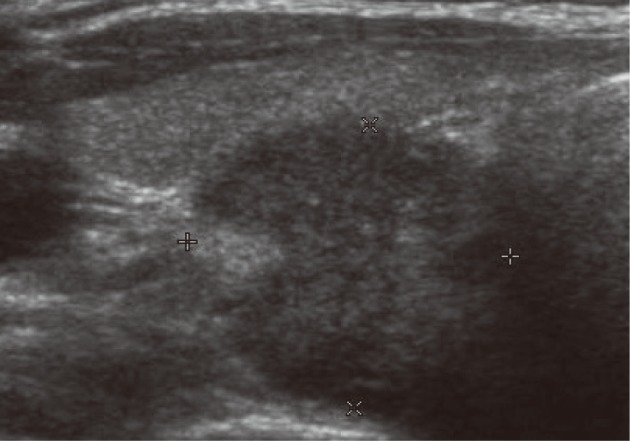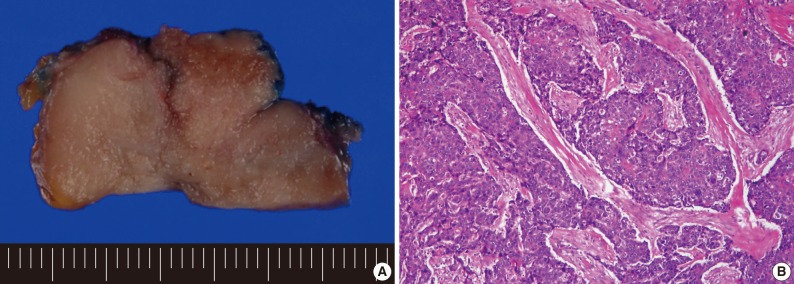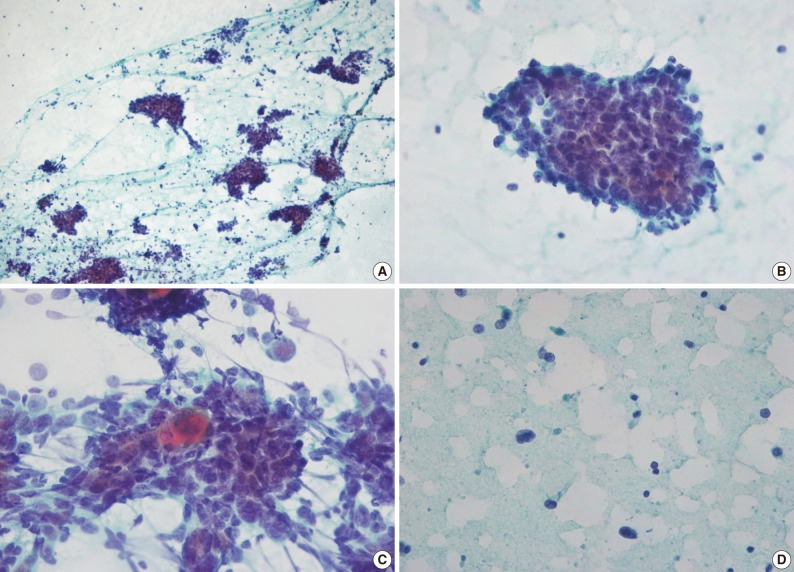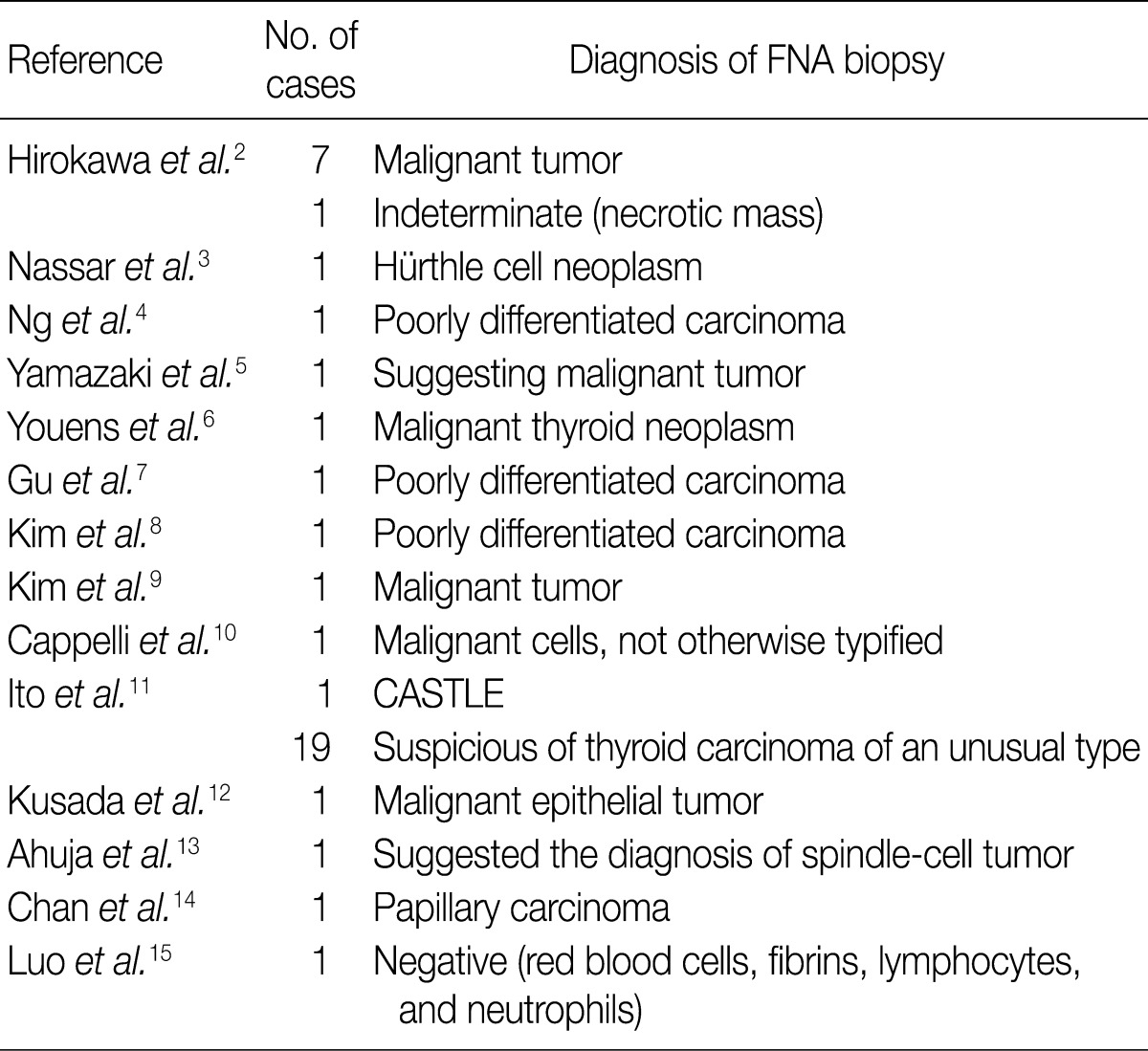Articles
- Page Path
- HOME > J Pathol Transl Med > Volume 46(3); 2012 > Article
-
Case Report
Cytologic Findings of Thyroid Carcinoma Showing Thymus-like Differentiation: A Case Report - Sunhee Chang, Mee Joo, Hanseong Kim
-
Korean Journal of Pathology 2012;46(3):302-305.
DOI: https://doi.org/10.4132/KoreanJPathol.2012.46.3.302
Published online: June 22, 2012
Department of Pathology, Inje University Ilsan Paik Hospital, Inje University College of Medicine, Goyang, Korea.
- Corresponding Author: Sunhee Chang, M.D. Department of Pathology, Inje University Ilsan Paik Hospital, Inje University College of Medicine,170 Juhwa-ro, Ilsanseo-gu, Goyang 411-706, Korea. Tel: +82-31-910-7138, Fax: +82-31-910-7139, changsh@paik.ac.kr
• Received: January 16, 2012 • Revised: March 25, 2012 • Accepted: April 25, 2012
© 2012 The Korean Society of Pathologists/The Korean Society for Cytopathology
This is an Open Access article distributed under the terms of the Creative Commons Attribution Non-Commercial License (http://creativecommons.org/licenses/by-nc/3.0) which permits unrestricted non-commercial use, distribution, and reproduction in any medium, provided the original work is properly cited.
Figure & Data
References
Citations
Citations to this article as recorded by 

- Fine‐Needle Aspiration Cytologic Diagnosis of Intrathyroidal Thymic Carcinoma: A Review of the Literature
Qi Chen, Xiaoli Yu
Diagnostic Cytopathology.2025; 53(10): 507. CrossRef - Preoperative Cytological Diagnosis of Intrathyroidal Thymic Carcinoma: A Case Report With Review of the Literature
Makoto Yamada, Shota Sezaki, Tomonari Ikeya, Masatoshi Furuta, Shogo Mizuno, Yoshiro Otsuki
Diagnostic Cytopathology.2025;[Epub] CrossRef - Coexistence of intrathyroid thymic carcinoma and papillary thyroid carcinoma: a case report and literature review
Maryam Vajihinejad, Ali Ataei, Mohammad Pashmchi, Ali Aledavoud, Vahid Zand, Mohammad Ali Broomand, Mohammad Mohammadi, Niloofar Zare Reshkuiyeh
Frontiers in Oncology.2024;[Epub] CrossRef - Intrathyroidal Thymic Carcinoma: A Retrospective Case Series Study
Jinhui Liang, Mei Huang, Helang Huang, Li Li, Hailin Luo, Weidong Mao, Shan Gao, Haoxiang Xu
Ear, Nose & Throat Journal.2023; 102(9): 584. CrossRef - Carcinoma showing thymus‐like differentiation of the parotid gland: The brief report of cytomorphology and review of the literature
Tomoko Uchiyama, Chiyoko Terada, Yuma Tachibana, Hirokazu Nishiura, Maiko Takeda, Tomomi Fujii, Takahiro Kimura, Masahiro Tsutsumi, Chiho Ohbayashi
Diagnostic Cytopathology.2023;[Epub] CrossRef - A case of concurrent occurrence of carcinoma showing thymus-like differentiation and follicular variant of papillary thyroid cancer in the same thyroid
Takahito Kimura, Keisuke Enomoto, Masamitsu Kono, Masanobu Hiraoka, Saori Takeda, Naoko Kumashiro, Shun Hirayama, Eri Kimura, Shunji Tamagawa, Makiko Ohtani, Shin-Ichi Murata, Muneki Hotomi
Journal of Surgical Case Reports.2022;[Epub] CrossRef - Ultrasonographic Features of Intrathyroidal Thymic Carcinoma: Review and Analysis of 10 Cases
Wang, MD Yanhai, Yang, MD Hua, Liu, MD Hanqing, Luo, MD Xiaoli, Liu, BS Luying, Zhou, BS Pingting
ADVANCED ULTRASOUND IN DIAGNOSIS AND THERAPY.2022; 6(2): 58. CrossRef - Thyroid carcinoma with thymus-like differentiation (CASTLE) tumor: а сase report
A. A. Ilyin, V. V. Polkin, P. A. Isaev, F. E. Sevrukov, N. Yu. Dvinskych, M. I. Ryzhenkova, S. A. Ivanov, A. D. Kaprin
Head and Neck Tumors (HNT).2021; 11(2): 64. CrossRef - Metastatic Renal Cell Neoplasm Within a Papillary Thyroid
Carcinoma as Incidental Finding in an Asymptomatic Patient: a Case Report
Maria-Rosa Bella-Cueto, Mireia Pascua-Solé, Albert Cano-Palomares, M. Àngels Cabezuelo-Hernandez, Maria-Rosa Escoda-Giralt, Santiago Barcons-Vilaplana, Paula Serret-Miralles, Carmen Caral-Vanaclocha, Xavier Guirao-Garriga, Joan Prats-Lopez, Meritxell Meda
SN Comprehensive Clinical Medicine.2020; 2(7): 978. CrossRef - Intrathyroidal thymic carcinoma exhibiting neuroendocrine differentiation: Case report with cytomorphology, immunocytochemistry, and review of the literature focusing on cytology
Wen‐hao Ren, Kun Dong, Xiao‐zheng Huang, Yan‐li Zhu
Diagnostic Cytopathology.2019; 47(11): 1197. CrossRef - Management and Prognostic Factors for Thyroid Carcinoma Showing Thymus-Like Elements (CASTLE): A Case Series Study
Rui Gao, Xi Jia, Ting Ji, Jinteng Feng, Aimin Yang, Guangjian Zhang
Frontiers in Oncology.2018;[Epub] CrossRef - Multiple squamous cells in thyroid fine needle aspiration: Friends or foes?
Heather Gage, Elizabeth Hubbard, Laurentia Nodit
Diagnostic Cytopathology.2016; 44(8): 676. CrossRef - Clinical analysis of 82 cases of carcinoma showing thymus-like differentiation of the thyroid
WEI GE, YONG-ZHONG YAO, GANG CHEN, YI-TAO DING
Oncology Letters.2016; 11(2): 1321. CrossRef - Carcinoma Showing Thymus-Like Differentiation (CASTLE): Cytopathological Features and Differential Diagnosis
Jennifer A. Collins, Bo Ping, Justin A. Bishop, Syed Z. Ali
Acta Cytologica.2016; 60(5): 421. CrossRef - Carcinoma Showing Thymus-Like Elements of the Thyroid Gland: Report of Three Cases Including One Case with Breast Cancer History
Guanjun Zhang, Xi Liu, Wei Huang, Xiaofeng Li, Marianne Johnstone, Yuan Deng, Yongqiang Ke, Quentin M. Nunes, Hongyan Wang, Yili Wang, Xuebin Zhang
Pathology & Oncology Research.2015; 21(1): 45. CrossRef - Potential Role of Adjuvant Radiation Therapy in Cervical Thymic Neoplasm Involving Thyroid Gland or Neck
Jae Myoung Noh, Sang Yun Ha, Yong Chan Ahn, Dongryul Oh, Seung Won Seol, Young Lyun Oh, Joungho Han
Cancer Research and Treatment.2014; 47(3): 436. CrossRef
Cytologic Findings of Thyroid Carcinoma Showing Thymus-like Differentiation: A Case Report



Fig. 1 Thyroid ultrasonography shows a 1.7-cm, well-defined, hypoechoic, solid mass in the lower pole of the right thyroid.
Fig. 2 (A) The smear shows cohesive sheets and clusters, and singly scattered cells. (B) Tumor cells have round to ovoid vesicular nuclei, small prominent nucleoli and scanty cytoplasm. A few lymphoid cells are present on the background and within the clusters. (C) Keratinization is seen. (D) Stripped nuclei are present in the background (A-D, Papanicolaou stain).
Fig. 3 (A) The cut surface of the tumor is lobulated, solid, and tan-colored. (B) Broad anastomosing islands of tumor cells are separated by desmoplastic stroma. Squamous differentiation is present.
Fig. 1
Fig. 2
Fig. 3
Cytologic Findings of Thyroid Carcinoma Showing Thymus-like Differentiation: A Case Report

Table 1 Diagnosis of CASTLE on the FNA biopsy in patients with CASTLE
CASTLE, carcinoma showing thymus-like differentiation; FNA, fine-needle aspiration.

 E-submission
E-submission




 PubReader
PubReader Cite this Article
Cite this Article




